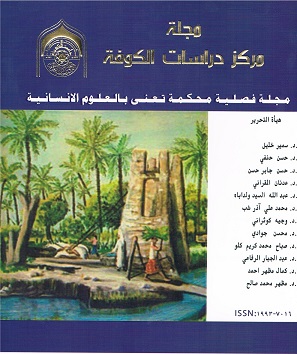شهابُ الدين الحلبي وجهودُهُ الأدبية Shihab Al-Din Al-Halabi and his efforts literary
DOI:
https://doi.org/10.36322/jksc.v1i40.4959Abstract
شهد القرن الثامن الهجري نشاطاً كبيراً في الحركة العلمية والأدبية ؛ وكان من بين من نبغ فيها من العلماء والأدباء : شهاب الدين بن فضل الله العمري ( ت 749هـ ) ، وزين الدين عمر بن الوردي ( ت 749هـ ) ، وصفي الدين الحلي ( ت 750هـ ) ، وجمال الدين محمد بن نباتة المصري ( ت 768هـ) ، وشهاب الدين الحلبي ( ت 725هـ ) الذي نحن بصدد التعريف به ، ودراسة نتاجه الأدبي . ولشهاب الدين الحلبي مكانة متميزة بين علماء تراثنا العربي ؛ لما بذله من جهود كبيرة في مجال خدمة اللغة العربية والوقوف على علومها المختلفة ، فضلاً عمّا خلفه لنا من تراث علمي وأدبي ضخم ومهم ؛ وهو بعد يعدُّ في الذروة من كتّاب الدواوين في العصر المملوكي ؛ لبلاغته ، ودقّة تفكيره ، وروعة أدائه ، وحسن تأتيه في الرسائل ، وقد احتل مكانة متميّزة في تاريخ الأدب العربي ، إذ جمع بين الكتابة والشعر ، كما كان ناقداً ذوّاقة له آراؤه البلاغية وأحكامه النقدية . وقد وجدنا في أدبه مادةً غزيرة للكشف عن طبيعة الحياة التي عاشها شهاب الدين الحلبي ، وسمات عصره الحافلة بالقلق والاضطراب الاجتماعي ؛ لذا وجدنا أنَّ هذا الأديب حرياً أن يدرس أدبه ، ففيه من نفائس الأدب وغرره ما يجعله أهلاً للبحث والدرس .
ومن هنا جاءت الدراسة في تمهيدٍ وثلاثة فصول ، وفي التمهيد حاولنا التعريف بشهاب الدين الحلبي من خلال استقراء سيرته ، وفي الفصل الأول تطرّقنا إلى رسائله وخصائص أسلوبه في الكتابة ، وأبرز سماته الفنية ، أما الفصل الثاني فقد تناولنا شعره وما تضمّنه من مضامين وخصائص فنيه ، في حين جاء الفصل الثالث في دراسة جهوده النقديّة في الأدب أدلى بها في مواقف ومناسباتٍ شتّى ؛ فضلاً عن جهوده البلاغية التي ألمع إليها في كتابه ( حسن التوسل إلى صناعة الترسل )
The eighth century Islamic realized a large of activity in the movement of scientific and literary , that this century filled with a large group of virtuous of men of letters , were among those who excelled in which scientists and writers : Shahab Al-Din bin Fadlallah age (749 AH ) , Zine Al-Din Omar bin Al-wardi (749 AH ) , Saifi Al-Din Al-Hali (750 AH ) , Jamal Al-Din Mohammed bin Nabata Al-Massrai ( 768 AH ) , and Shahab Al-Din Al-Halabi (725 AH ), which we are going to define him and study his production literary .
Shahab Al-din Al-Halabi had privileged position among our Arab scientists heritage for his great efforts in the field of Arabic language service and stand on the sciences different , as well as what is left to us of the heritage of scientific and literary huge and important , which is at the top of the poetical works writers in the Mamluk era , for his eloquence , precision of his thinking , and the his splendor in the Letters. He has occupied a unique place in the history of Arabic literature . As he gathered between writing and poetry . Also, he was a tact critic have rhetorical views and critical decisions .And found in his literary a heavy material to reveal about the nature of life which lived by Shihab al-Din al-Halabi , and characteristics of his age which filled with unrest and social disturbance , so we found that this writer have to study his literary because it's include the precious literature and this made it qualified for research and lesson.
And from there the study came in preface and three section s , in the preface we tried to the definition about Shahab Al-din Al-Halabi through induction of his biography .In the first section, we deal with his letters ,his style in writing and his artistic characteristics. The second section we talked about his poetry and what it included from contents and artistic characteristics. The third section, we talked about study of his critical efforts which expressed about them in different attitudes and occasions
Downloads
Downloads
Published
How to Cite
Issue
Section
License
Copyright (c) 2022 مجلة مركز دراسات الكوفة | Journal of Kufa Studies Center

This work is licensed under a Creative Commons Attribution 4.0 International License.
Permit others to distribute and copy the manuscript, to create extracts, abstracts, and other revised versions, adaptations, or derivative works of or from the manuscript (such as a translation), to include in a collective work, to text or data mine the article, even for commercial purposes, as long as they credit the author(s), do not represent the author as endorsing their adaptation of the article, and do not modify the article in such a way as to damage the author''''s honor or reputation. Further details are found at Creative Commons Attribution 4.0 International (CC BY 4.0)






























